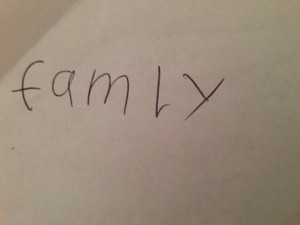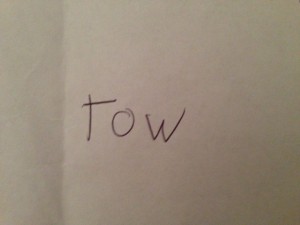guest blog by Dr. Kelli Sandman-Hurley
Dyslexia Training Institute
Spelling mistakes are not just annoyances that are begging to be marked with a red pen. They aren’t the sign of laziness and we really don’t need to respond to them with derision or with an extra assignment to write the word over and over again in the hopes that the student will remember it.
Instead spelling mistakes are a gift; a chance to peer into the inner workings of your students’ minds. They provide a rich landscape for us to explore and they help us develop a deep understanding of what our students truly understand about English orthography, perhaps far more information than reading assessments.
It’s the window into the student’s academic soul.
So, what is this golden opportunity handed to us via spelling mistakes?
Spelling Mistake # 1: Sounding Out Words

I think we have all see the words
and spelled as and . The mistake here is that the student is spelling by sound first. He or she believes that if we ‘sound out’ a word then we will be able to spell it, but we all know that does not work much of the time, as our spoken syllables don’t always match our written syllables.
Students’ (Mis)Understanding #1 - In the cases of and the student does not understand that the way we pronounce a word and the way we spell it can, and often is, different. When we teach kids how to spell by "sounding out" unfamiliar words, sometimes we are expecting them to speak unnaturally by pronouncing syllables we do not pronounce when speaking naturally. Also, when we dictate words to students we often speak unnaturally to help them hear each spoken syllable. But is this really helpful? How often will other people in their life stop to over-enunciate spelling words for them?
Try this: Pronounce the word out loud. I'm going to guess that what you said can be represented this way: /'ɛvri/. Am I right? How many syllables did you pronounce? Probably two (unless you over-enunciated the word). Now study the word , and I mean think about what it means. Then look at how many syllables are represented in writing. Three. As teachers, we then over-enunciate the word to help the child hear all the phonemes in each syllable in order to help him or her spell the word. The problem is that by over-enunciating the spoken syllables we are repeatedly misrepresenting how the written word works.
Teaching (Re)Solution: So for the word every, we start with a conversation about what the word means. You can have the student use the word in a sentence or phrase or they can explain it to you. If they are not sure give them a sentence using the word to see if that triggers a conversation. A quick trip to the Online Etymology Dictionary reveals that every is related to ever. Now the student can hypothesize that the base is . The medial in is no longer a mystery or something to be memorized, because it is now understood. The word sum is ever + y —> every.
Now, let’s try the word family. Say it out loud and I bet you will pronounce two syllables again and that medial seems to disappear when spoken. However, the reason for the medial in becomes apparent when we ask the student to consider other words that are related to the word like . The hypothesized base in these words is . Now we can discuss with the student why we elide the in when we speak but see that the is pronounced in other words with that base.
Spelling Mistake #2: Not thinking about grammar when spelling.
The suffix <-ed> is often pronounced as /d/ , /t/ or /əd/; when misspelled by the student it can look this this: , and . Once again, the student believes if he or she can sound out the word, it can be spelled. In this case the student is not thinking about grammar while spelling.
(Mis)Understanding #2 - The student does not understand that spelling and grammar are connected. I am sure that at some point in their academic careers these same students have learned that when <-ed> is a suffix it can (but not always) represent /d/, /t/ or /əd/ in order to mark the past tense of a word. So, why oh why do they keep making this mistake? It is most likely the students have not made the connection that spelling and grammar are intimately connected because spelling is usually taught in isolation. They have not made the connection that when they add morphemes, like suffixes, they may be changing the grammatical structure of word, this requires that they think about what the word means in order to be able to understand the spelling of the word.
They are also still under the impression that it is possible to tap out the sounds in any word to spell it and when that does not work, they are at a loss.
Teaching (Re)Solution: Teach by helping students discover that spelling and grammar are integral to each other. When this happens a student will begin to think about what the word means and then how to represent the past tense in this word. So, one way to guide this discovery is to ask the student, what does /kist/ mean? This is done by talking about the word, not looking at the word. The student will invariably discover that /kist/ means someone did some kissing previously and it is past tense.
That discovery will lead to another discovery that <-ed> is one way to mark past tense and is spelled regardless of its pronunciation. This also goes for words with the <-ion> suffix. When a student spells the word action as , or some variation of that misspelling, we have stumbled upon a significant amount of information. Like the <-ed> suffix above, the student needs to learn that <-ion> is a noun-forming suffix. By discussing what the word means they will discover that the base is and the suffix is , then they can see that the has to be in the word and that it is part of the base. They will also discover the the grapheme has different possible pronunciations. In the pronunciation of act the spells /t/, which is what most students are taught represents. However, they have been left in the dark regarding other pronunciations of like in the pronunciation of action where the spells /ʃ/, signaled by the subsequent in the suffix.
Spelling Mistake #3: Memorizing Words
We teach words that don’t seem to follow any rules as words they just need to be memorized. The words and are perfect examples.
(Mis)Understanding #3 - The student does not understand there is a reason for every letter in every word and with a little orthographic investigation those reasons can by discovered through inquiry.
Teaching (Re)Solution: When you and a student come across a word like this, the first thing a student should do is come up with a hypothesis about why the word two contains the letter and then go in search of the evidence. Talk about what the word means and about other words that share a meaning with the word two. They will most likely come up with word like twice, twin, twelve, twenty, between, twilight and possibly more. Now they have the evidence they need to discover: the is there in two to mark its the relationship of the other words that share meaning with the word two.
Now, if you look at the word people in The Online Etymology Dictionary (after you have discussed its meaning) the student will discover it is derived from the Latin populous. This is a great opportunity to talk about how many English words started as Latin words (not to mention Greek, Old English and French). Invite the students to pose a hypothesis (with some guidance, of course or if necessary). "Is it possible that the in people is there to mark its connection to populous or population?" It's certainly plausible since they share meaning. Then you can follow that up with "what other words might be related to the word people?" A quick trip back to Etymonline.com confirms that populous and population are related to people. Aha! That's why that pesky is in people.
With just seven words we have uncovered three very important misunderstandings our students have about how English orthography is structured. That is pretty powerful information. We can now use that information to direct our teaching and student’s learning/discovery of why words are spelled the way they are in English. And it’s not just spelling, think about how they will look at words differently when they are reading when they begin to discover through their own investigations how the pronunciation (decoding) of words is dependent on how the morphemes interact with each other in a word.
It is easy, and all too common, to toss spelling aside as unimportant and some schools have even stopped explicitly teaching it altogether.
is come up with a hypothesis about why the word two contains the letter and then go in search of the evidence. Talk about what the word means and about other words that share a meaning with the word two. They will most likely come up with word like twice, twin, twelve, twenty, between, twilight and possibly more. Now they have the evidence they need to discover: the is there in two to mark its the relationship of the other words that share meaning with the word two.
Now, if you look at the word people in The Online Etymology Dictionary (after you have discussed its meaning) the student will discover it is derived from the Latin populous. This is a great opportunity to talk about how many English words started as Latin words (not to mention Greek, Old English and French). Invite the students to pose a hypothesis (with some guidance, of course or if necessary). "Is it possible that the in people is there to mark its connection to populous or population?" It's certainly plausible since they share meaning. Then you can follow that up with "what other words might be related to the word people?" A quick trip back to Etymonline.com confirms that populous and population are related to people. Aha! That's why that pesky is in people.
With just seven words we have uncovered three very important misunderstandings our students have about how English orthography is structured. That is pretty powerful information. We can now use that information to direct our teaching and student’s learning/discovery of why words are spelled the way they are in English. And it’s not just spelling, think about how they will look at words differently when they are reading when they begin to discover through their own investigations how the pronunciation (decoding) of words is dependent on how the morphemes interact with each other in a word.
It is easy, and all too common, to toss spelling aside as unimportant and some schools have even stopped explicitly teaching it altogether.
But this article isn’t about creating perfect spellers, it’s about gaining a deep understanding about what our students actually understand about the structure of their own language.
We can then help our students develop the inquiry skills they need to seize the opportunity to understand their language on a deep, sophisticated level that will help them not only with spelling, but with reading and vocabulary. And you got all this information from seven common words!
 Kelli Sandman-Hurley, Ed.D. is the co-founder of the Dyslexia Training Institute. She received her doctorate in literacy with specialization in reading and dyslexia. She is a certified special education advocate assisting parents and children through the Individual Education Plan (IEP) and 504 Plan process. Kelli is trained in Structured Word Inquiry, Orton-Gillingham, Lindamood-Bell, RAVE-O and Wilson Reading Programs. Kelli is the past-President of the San Diego Branch of the International Dyslexia Association. She co-created and produced “Dyslexia for a Day: A Simulation of Dyslexia,” is a frequent speaker at conferences, and is currently writing “Dyslexia: Decoding the System.”
Kelli Sandman-Hurley, Ed.D. is the co-founder of the Dyslexia Training Institute. She received her doctorate in literacy with specialization in reading and dyslexia. She is a certified special education advocate assisting parents and children through the Individual Education Plan (IEP) and 504 Plan process. Kelli is trained in Structured Word Inquiry, Orton-Gillingham, Lindamood-Bell, RAVE-O and Wilson Reading Programs. Kelli is the past-President of the San Diego Branch of the International Dyslexia Association. She co-created and produced “Dyslexia for a Day: A Simulation of Dyslexia,” is a frequent speaker at conferences, and is currently writing “Dyslexia: Decoding the System.”